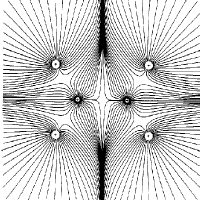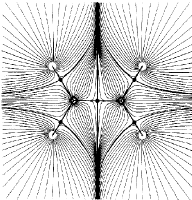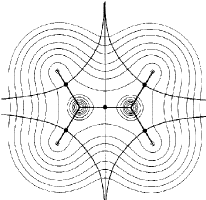Figure 4. Maps of the gradient vector field of the electron density for the same plane containing the nuclei shown in Figure 1. Each line represents a trajectory traced out by the vector ![]()
![]() (r).
(r).
| Figure 4. (a) A display of the trajectories that terminate at the nuclei. Each trajectory is arbitrarily terminated at the surface of a small circle centered on the nucleus. The set of trajectories that terminate at a given nucleus (attractor) cover the basin of the attractor.
|

|
| Figure 4. (b) The same as (a) but including the sets of trajectories which terminate and originate at the bond critical points (denoted by dots). Only one pair of an (infinite) set of trajectories that terminate at the critical point lie in this plane. |

|
| Figure 4. (c) A contour map of the electron density overlaid with the bond paths that define the molecular graph and with the trajectories that mark the intersection of the interatomic surfaces with this plane and define the boundaries of the atomic basins. |

|
Return to Theory of Atoms in Molecules: "What is a Bond"
Go to: Richard Bader's Home Page | Chemistry Faculty | Chemistry Welcome Page.
Last update: 23feb96, rfwb
"));